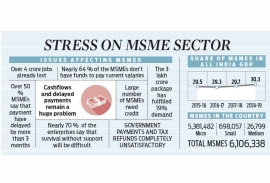Government boosters have failed to lift sick MSMEs amid lockdown: Associations

NEW DELHI: Government schemes aimed at reviving the MSMEs hit by the double whammy of slowdown and corona-induced lockdown have done little to lift the sector, according to MSME associations.
Nearly 20-30 per cent of the workforce employed in over 6 crore micro, small and medium enterprises in the country has been rendered jobless in last four month, they said. Over 60 per cent of the MSME units don’t have enough funds to pay salaries to their existing employees.
Lack of demand, liquidity crunch, delayed cash flows and manpower crunch have taken its toll on the MSME sector which is one of the biggest employers and contributes nearly 30 per cent to India’s GDP.
MSME associations say though there is no government on the actual number of jobs in the MSME sector, at least 20 crore people are earning their livelihoods through this sector.
Chandrakant Salunkhe, president, SME Chamber of India, said most of the units are running with nearly 30-35 per cent of the manpower. All companies are facing problems with supply of raw materials.
Raw materials are available but it needs cash and MSMEs do not have cash in hand,- he said.
Export orders have slowed down. So, the companies mainly involved in exports are not manufacturing. MSMEs which used to supply these exporters are also facing problems.”
“The whole chain has got affected,- said Salunkhe.
A recent RBI survey also pointed out towards the stress in the sector, accentuated by -lack of cash flows… low demand, lack of manpower, stuck working capital and lack of capital.
Nearly, 60 per cent respondents in the RBI survey believed that chances of recovery in the MSME sector – which suffered from massive labour migration, production halt, and cash flow crunch during the lockdown in the next six months were bleak, while 40 per cent felt it would be moderate.
With a view to support the ailing sector, the government decided to provide Rs 3 lakh crore in collateral-free automatic loans to MSMEs aimed at providing additional working capital to existing customers of banks under Atmanirbhar Bharat scheme.
However, MSME associations have said it has not helped much. Anil Bhardwaj, secretary general, Federation of Indian Micro and Small & Medium Enterprises, said the scheme has limited benefits.
This is like if you have any due on February 29, then you would get 20 per cent of that due collateral free and this is it. You would not get anything if you don’t have any loan. So this scheme is only for existing borrowers,- he said.
There are many ifs and buts and the scheme is not as successful as it has been projected.-Bhardwaj said most of the MSMEs which have not taken loans have scaled/shut down their business.
Enterprises involved in hotels, restaurants, event managements, weddings have been affected very badly.
Referring to a recent survey, he said nearly 64 per cent MSMEs don’t have funds to pay current salaries and a large number of MSMEs need credit as the Rs 3 lakh crore package has fulfilled just 19 per cent of the demand. MSME associations say the real situation will evolve after the end of the moratorium period.
The RBI has given moratorium till August 31. But, the main issue is what will happen after that. Actually this is not a solution; it is a temporary support. At least the moratorium should be extended further till the year-end,- Salunkhe said.
He also raised questions on the approach of banks.
There are around 6.5 crore MSME units in India of which only 40-45 lakh enjoy bank facilities Either banks are not reaching them or MSMEs are not interested in taking loans from banks as interest is high and getting a loan is not easy,-said Salunkhe
Recent Posts
- Maharashtra Industry Dialogue 2025
- Maharashtra Industries & SME Summit Celebrates Sustainable Industrial Growth and Foundation Milestones
- India can become a global ‘power engine’ if youth skills are enhanced
- Sanand Industries Association joined the hands with SME Chamber of India and Gujarat Industry Development Association (GIDA) to pave the way for new growth opportunities!
- Appeal to the Chief Minister to solve the problems of entrepreneurs